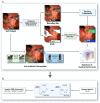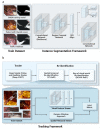Evaluation of Surgical Skills during Robotic Surgery by Deep Learning-Based Multiple Surgical Instrument Tracking in Training and Actual Operations
- PMID: 32585953
- PMCID: PMC7355689
- DOI: 10.3390/jcm9061964
Evaluation of Surgical Skills during Robotic Surgery by Deep Learning-Based Multiple Surgical Instrument Tracking in Training and Actual Operations
Abstract
As the number of robotic surgery procedures has increased, so has the importance of evaluating surgical skills in these techniques. It is difficult, however, to automatically and quantitatively evaluate surgical skills during robotic surgery, as these skills are primarily associated with the movement of surgical instruments. This study proposes a deep learning-based surgical instrument tracking algorithm to evaluate surgeons' skills in performing procedures by robotic surgery. This method overcame two main drawbacks: occlusion and maintenance of the identity of the surgical instruments. In addition, surgical skill prediction models were developed using motion metrics calculated from the motion of the instruments. The tracking method was applied to 54 video segments and evaluated by root mean squared error (RMSE), area under the curve (AUC), and Pearson correlation analysis. The RMSE was 3.52 mm, the AUC of 1 mm, 2 mm, and 5 mm were 0.7, 0.78, and 0.86, respectively, and Pearson's correlation coefficients were 0.9 on the x-axis and 0.87 on the y-axis. The surgical skill prediction models showed an accuracy of 83% with Objective Structured Assessment of Technical Skill (OSATS) and Global Evaluative Assessment of Robotic Surgery (GEARS). The proposed method was able to track instruments during robotic surgery, suggesting that the current method of surgical skill assessment by surgeons can be replaced by the proposed automatic and quantitative evaluation method.
Keywords: deep learning; quantitative evaluation; robotic surgery; surgical instrument tracking; surgical skills.
Conflict of interest statement
The authors declare no conflict of interest.
Figures






Similar articles
-
A Comparison of Robotic Simulation Performance on Basic Virtual Reality Skills: Simulator Subjective Versus Objective Assessment Tools.J Minim Invasive Gynecol. 2017 Nov-Dec;24(7):1184-1189. doi: 10.1016/j.jmig.2017.07.019. Epub 2017 Jul 27. J Minim Invasive Gynecol. 2017. PMID: 28757439 Clinical Trial.
-
Video-based surgical skill assessment using 3D convolutional neural networks.Int J Comput Assist Radiol Surg. 2019 Jul;14(7):1217-1225. doi: 10.1007/s11548-019-01995-1. Epub 2019 May 18. Int J Comput Assist Radiol Surg. 2019. PMID: 31104257
-
Discrimination, Reliability, Sensitivity, and Specificity of Robotic Surgical Proficiency Assessment With Global Evaluative Assessment of Robotic Skills and Binary Scoring Metrics: Results From a Randomized Controlled Trial.Ann Surg Open. 2023 Aug 16;4(3):e307. doi: 10.1097/AS9.0000000000000307. eCollection 2023 Sep. Ann Surg Open. 2023. PMID: 37746611 Free PMC article.
-
Surgical instrument detection and tracking technologies: Automating dataset labeling for surgical skill assessment.Front Robot AI. 2022 Nov 4;9:1030846. doi: 10.3389/frobt.2022.1030846. eCollection 2022. Front Robot AI. 2022. PMID: 36405072 Free PMC article. Review.
-
Objective Assessment of Robotic Surgical Technical Skill: A Systematic Review.J Urol. 2019 Mar;201(3):461-469. doi: 10.1016/j.juro.2018.06.078. J Urol. 2019. PMID: 30053510
Cited by
-
Cloud Based AI-Driven Video Analytics (CAVs) in Laparoscopic Surgery: A Step Closer to a Virtual Portfolio.Cureus. 2022 Sep 12;14(9):e29087. doi: 10.7759/cureus.29087. eCollection 2022 Sep. Cureus. 2022. PMID: 36259009 Free PMC article.
-
Limited generalizability of single deep neural network for surgical instrument segmentation in different surgical environments.Sci Rep. 2022 Jul 22;12(1):12575. doi: 10.1038/s41598-022-16923-8. Sci Rep. 2022. PMID: 35869249 Free PMC article.
-
Automated surgical skill assessment in endoscopic pituitary surgery using real-time instrument tracking on a high-fidelity bench-top phantom.Healthc Technol Lett. 2024 Dec 2;11(6):336-344. doi: 10.1049/htl2.12101. eCollection 2024 Dec. Healthc Technol Lett. 2024. PMID: 39720762 Free PMC article.
-
Evaluation of objective tools and artificial intelligence in robotic surgery technical skills assessment: a systematic review.Br J Surg. 2024 Jan 3;111(1):znad331. doi: 10.1093/bjs/znad331. Br J Surg. 2024. PMID: 37951600 Free PMC article.
-
Video-based formative and summative assessment of surgical tasks using deep learning.Sci Rep. 2023 Jan 19;13(1):1038. doi: 10.1038/s41598-022-26367-9. Sci Rep. 2023. PMID: 36658186 Free PMC article.
References
-
- Hilal Z., Kumpernatz A.K., Rezniczek G.A., Cetin C., Tempfer-Bentz E.-K., Tempfer C.B. A randomized comparison of video demonstration versus hands-on training of medical students for vacuum delivery using Objective Structured Assessment of Technical Skills (OSATS) Medicine. 2017;96:11. doi: 10.1097/MD.0000000000006355. - DOI - PMC - PubMed
Grants and funding
LinkOut - more resources
Full Text Sources
Other Literature Sources
Research Materials

